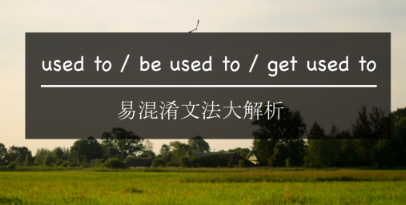used to:表示过去经常做的行为,但现在不再发生了。
使用方法: used to + V (动词原型)
其中的 to 是不定词,而不是介系词,所以后面只能接动词原型。
肯定句
He used to smoke.
他过去常抽烟。
否定句:直接在 used 后面加上 “not”;或加上助动词 “didn’t”
He used not to smoke.
他过去不常抽烟。
He didn’t use to smoke.
他过去不常抽烟。

疑问句:将 “Did” 放于句首;或加在最后面形成「反问句」
Did he use to smoke?
他过去常抽烟吗?
He used to smoke, didn’t he?
他过去常抽烟,对吧?
【小提醒】
used to 不能和「具体的次数 (e.g., four times)」或「一段时间 (e.g., two years, six months)」一起使用,但可以和频率副词 (e.g., always, usually, seldom) 连用。
I used to go to Hong Kong. (O)
I used to go to Hong Kong five times. (X)
我过去常去香港。
be used to:分为两种用法
用法一:描述物品被用来做某件事情。
使用方法:物 + be used to + V (动词原型)
这里的 “used” 是 use 的被动语态,而 to 是不定词,后面要加动词原型。
Pesticide is used to protect crops from pests.
杀虫剂是用来避免农作物受到害虫侵袭。
用法二:指人习惯于某样东西或某件事。
使用方法:人 + be used to + Ving (动名词) / N (名词)
这里的 to 是介系词,所以后面要加动名词或名词。
Tom is used to noise.
汤姆习惯于噪音。
Tom is used to living on a noisy street.
汤姆习惯居住于嘈杂的街道。
get used to:表示从「不习惯」到「习惯」的过程,意思是变得习惯于、开始习惯于某件事或物。
使用方法:人 + get used to + Ving (动名词) / N (名词)
Since Tom moved to that street, he has gotten used to noise.
自从汤姆搬到那条街道,他已经变得习惯于噪音。
Tom wasn’t used to noise. It took him some time to get used to it.
汤姆之前不习惯于噪音环境,他花了点时间才开始习惯。
看完这篇文章后,希望大家都能更清楚了解以上三种用法







